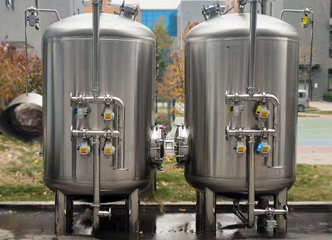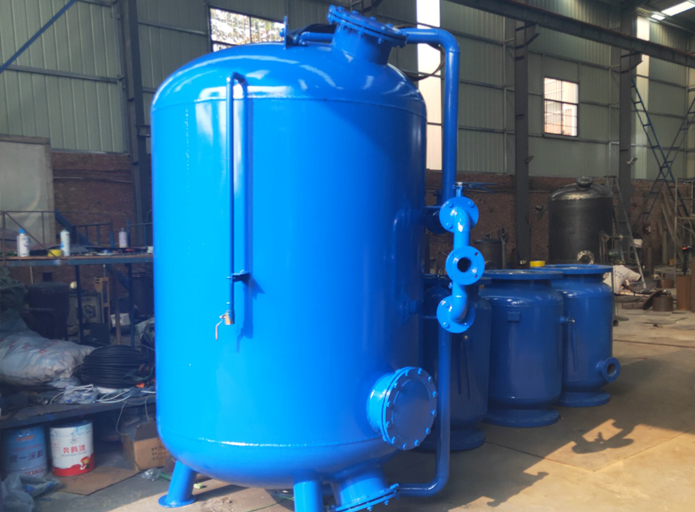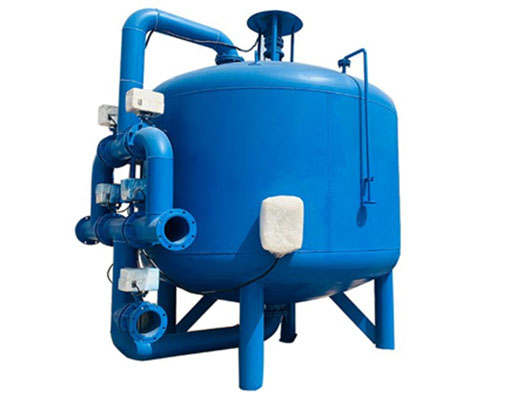A multi-media filter is a filtration device composed of two or more filter media. It is mainly used to remove suspended solids, impurities and certain trace pollutants in water. In electrical sewage treatment, multi-media filters have important application value. The following is a more detailed application introduction:
1. Wastewater pretreatment
In the initial stage of sewage treatment, multi-media filters can effectively remove suspended impurities, trace minerals, sediment and some organic matter in electrical sewage. Considering that multi-media filters are reusable, their filter layers can be backwashed It is reused, so the treatment at this stage is very economical and stable, significantly improving the ability to remove particles, thus achieving the effect of equipment pretreatment.
2. Deep processing
For electrical wastewater that requires deep treatment, such as wastewater containing heavy metal ions produced by electroplating and electrolysis in the electronics industry, multi-media filters can be combined with chemical precipitation, electrolysis and other processes to further improve the filtration effect. Especially between closely arranged filter materials, many tiny gaps can be formed, which can effectively capture and exclude smaller impurity particles.
3. Coarse, medium and fine filtration
Multi-media filters are often used in the treatment of oily sewage in electrical sewage treatment. It can effectively remove oil and some turbid substances in sewage to varying degrees, and meet different levels of filtration requirements for sewage.
4. Turbidity and SDI value control
Multi-media filters can effectively reduce the SDI value of water, which is the amount of suspended solids in the water, thereby further reducing the turbidity of the effluent. Clean water quality is not only beneficial to the service life of subsequent treatment equipment, but can also reduce operation and maintenance costs and improve the operating efficiency of the entire equipment.
5. Low cost and environmentally friendly
The application of multi-media filters can achieve low-cost and environmentally friendly effects. Low operating costs and simple operation make it widely used in electrical sewage treatment. The filter material can be used multiple times after backwashing, which reduces the cost of replacing and processing the filter material. It also reduces secondary pollution and is more in line with current environmental protection and sustainable development requirements.
In general, multi-media filters play an important role in electric sewage treatment, greatly improving the quality of water treatment and ensuring the realization of power production and environmental protection goals.

The working principle of multi-media filter mainly involves the following parts:
1. Use filter media to remove suspended solids. Multi-media filters treat water quality from a physical perspective. It mainly uses filter media filled inside the filter, such as quartz sand, anthracite and other filter materials, to remove suspended solids in raw water. The principle is that through physical filtration, when water containing suspended solid particles flows through the filter material layer, the suspended solids in the water are intercepted and attached to the filter material due to factors such as size and shape, and are thus removed from the water body.
2. The principle of adsorption is used to remove particles. When the water containing suspended particles is fully mixed with the flocculant, the double electric layer of the colloidal particles will be compressed, making the colloidal particles easy to be adsorbed by the filter material. When the colloidal particles flow through the filter material layer of the multi-media filter, the gaps in the filter material screen the suspended solids, making it easy for the suspended solids to be adsorbed on the surface of the filter material.
3. Backwashing and cleaning: After the suspended solids and other impurities adsorbed on the surface of the filter material reach a certain level, the resistance of the filter layer will rise, and backwashing is required at this time. Backwashing will clean the impurities adsorbed on the surface of the filter material so that the filter material can be used again. This process usually uses water from the upper water storage device to backwash the filter, and shortens the cleaning cycle by controlling the intensity and time of backwashing.
4. Principle of particle size stratification. The particle sizes of the filter media are arranged layer by layer from large to small. The coarse-grained and fine-grained filter materials are layered in sequence. This not only makes full use of the filter media, but also effectively avoids the interaction of filter materials. The mutual friction between them achieves the best filtration effect.
In short, the working principle of a multi-media filter is mainly to use the filter medium to physically filter suspended solids in the water. Through the selection and layered arrangement of particle size, as well as the use of adsorption principles and timely backwashing, to achieve the removal of raw water. suspended solids and improve water quality.
The backwashing of multi-media filters is a critical process. In order to maintain the filtration effect and the effectiveness of the filter material, the backwashing process of multi-media filters can be divided into four stages. The following is a detailed explanation of the backwashing process:
1. Stop the filter. During the backwashing process, the filter needs to be stopped first. This is to prepare for the backwash operation and prevent the impact of water flow caused when the backwash valve is opened, affecting the normal operation of the equipment.
2. Cut off the water source and open the relevant valves. Next, you need to cut off the water inlet and outlet valves, and then open the air discharge valve and the backwash discharge valve. This is to allow the equipment to better clean the filter material layer and successfully discharge impurities in the filter material layer during the backwashing process.
3. Start backwashing. After opening all necessary valves, start the backwash water pump and slowly open the backwash water inlet valve. This is to allow the water flow to penetrate the filter material layer evenly and flow in the opposite direction under a certain pressure, causing the filter material to expand and better bring out the impurities between the filter materials.
4. Adjust the backwash flow rate according to the actual working conditions until the normal backwash water flow rate is reached. This is to ensure that the filter material can be effectively washed during the backwashing process without flushing the filter material out of the filter. The backwash flow rate is usually controlled at about 30 m/s. The main criterion is that the filter material (such as anthracite) is not washed away.
It is worth noting that backwashing of the filter needs to be carried out regularly, usually once every 2-3 days, and will be adjusted according to the turbidity of the raw water and the working condition of the filter. If the turbidity is too high or the filter is overloaded, the backwash intervals may need to be shortened.
In general, backwashing is an important part of maintaining the long-term and efficient operation of multi-media filters. Correct and timely backwashing can effectively restore filtration performance, reduce the accumulation of garbage and sediment, and extend the service life of the filter material.

Multi-media filters have the following detailed advantages:
1. Efficient filtration capacity: Multi-media filters use one or several filter media to pass water with higher turbidity through a certain thickness of granular or non-granular materials under a certain pressure, thereby effectively removing pollutants from the water. Suspended impurities clarify the water. Its high-efficiency filtration ability can effectively and completely remove impurity particles from water.
2. Easy to use and operate: The multi-media filter is very simple and easy to use, easy to operate and manage during installation, commissioning and actual operation.
3. A variety of filter media and efficient filtration processing capacity: Commonly used filter materials include quartz sand, activated carbon, peanut shells and anthracite coal. By using a variety of filter media, impurities of different particle sizes and properties can be removed in a targeted manner.
4. Resistant to strong acids and alkalis, anti-oxidation, and good anti-pollution properties: Multi-media filters have the advantages of small filtration resistance, large specific surface area, resistance to strong acids and alkalis, anti-oxidation, PH range 2-13, and good anti-pollution properties, making it The device becomes an economical and effective way to filter.
5. Able to remove a variety of impurities: Activated carbon media has excellent adsorption properties and can remove organic matter, abnormal colors, odors and some dissolved substances. Activated carbon media filters are commonly used in water treatment to remove residual chlorine, organic pollutants and odors, and are suitable for various situations.
6. Wide range of applications: Multi-media filters have important applications in the industrial field. Their multiple filter media, efficient processing capabilities and other features make them an ideal choice for enterprises to improve the quality of cleaning water.
In short, multi-media filters have become an indispensable part of modern industrial water treatment due to their excellent performance and wide range of applications. However, when using a multi-media filter, you should also pay attention to regular replacement of the filter material to maintain the efficient performance of the filter. At the same time, backwashing is performed regularly to ensure the long-term stable operation of the filter.

The detailed structure of the multi-media filter is as follows:
1. Tank body: The tank body is the main body of the filter. It is usually made of carbon steel and coated with anti-corrosion coating, or made of stainless steel such as 304 or 316. The inner surface of the tank is usually coated with a layer of epoxy resin or natural rubber for anti-corrosion treatment to ensure the stability and durability of the equipment.
2. Water distribution component: The main task of the water distribution component is to evenly distribute the water entering the filter on the surface of the filter material, ensuring the uniformity of water flowing through the filter material, so as to make full use of the filter material for filtration.
3. Support component: The support component is usually made of stainless steel. Its main task is to support the filter material layer and prevent the filter material from being flushed into the lower sewage system during the backwashing process. The design of the support assembly and its pore size need to be able to prevent the passage of filter media while maintaining sufficient porosity to allow water to pass through.
4. Backwash pipe: The backwash pipe is usually located at the bottom of the equipment. Its task is to send the backwash water to the bottom of the filter material when backwash operations are required, forming a reverse water flow from bottom to top, and removing the filter material. The impurities in the space are washed away.
5. Filter material: The filter material is the core part of the equipment that can achieve the filtration effect. A variety of filter materials with different mesh sizes and physical properties are usually used for matching, such as quartz sand, activated carbon, anthracite, etc., to achieve filtering of different particle sizes. , nature of impurities for the most effective filtration.
6. Exhaust valve: There is usually an exhaust valve on the top of the equipment. Its main task is to remove air during the water filling or backwashing process of the equipment to ensure the normal operation and filtration effect of the equipment.
7. Supporting pipelines and valves: The main task of supporting pipelines is to send water into or discharge water from the equipment. At different stages during the operation of the equipment, valves will be operated to change the flow direction in the pipeline to ensure the normal operation of the equipment.
8. Water collection system: The water collection system is mainly used to collect filtered water. It usually includes a water collection pipe set at the bottom of the filter and a valve for drainage. The water collection system can also be equipped with an anti-siphon device to prevent the filter from being flooded with water after shutdown.
It should be noted that the above structure may differ due to different equipment models or manufacturers. The exact equipment structure should be based on the actual equipment on site. In addition, the operation and maintenance of the equipment also require careful attention. These include regular replacement of filter materials, setting of backwash frequency, and monitoring pressure and flow changes during equipment operation to ensure normal operation of the equipment and good filtration effects. .








